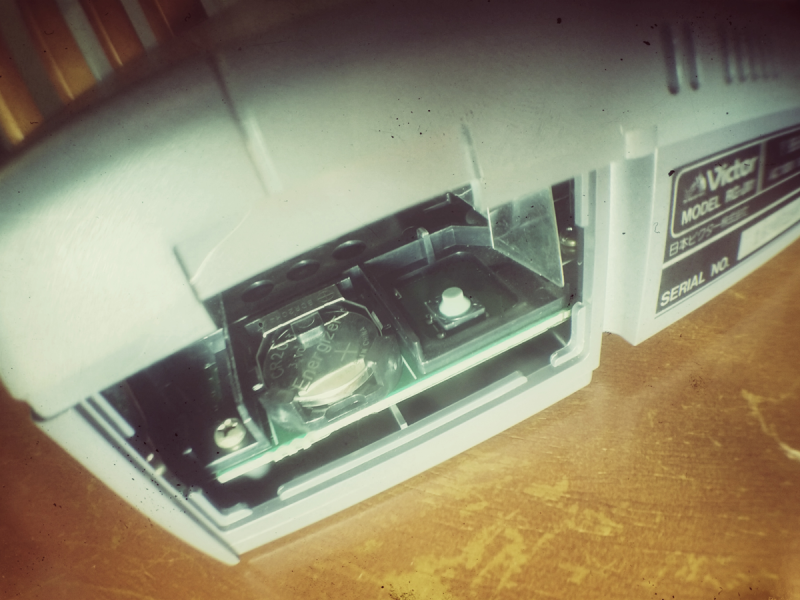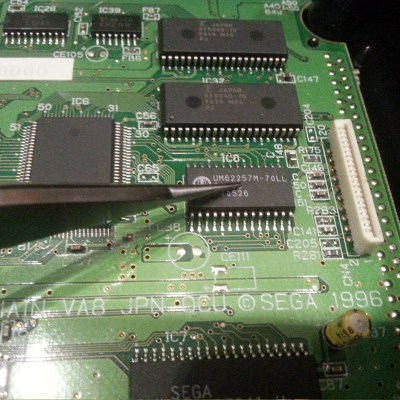Breaking out the Sega Saturn out of the closet for a hit of 90’s nostalgia comes with its own set of compromises: the wired controllers, the composite video, and worst of all that dead CR2032 battery behind the backdoor. Along with the death of that battery went your clock and all those precious hours put into your game save files. While the bulk of us kept feeding the insatiable SRAM, a friendly Canadian engineer named [René] decided to fix the problem for good with FRAM.
The issue with the battery-backed memory in the Saturn stems from the particularly power-hungry factory installed SRAM chip. Normally when the console is plugged-in to a main power source the CR2032 battery is not in use, though after several weeks in storage the battery slowly discharges. [René’s] proposed solution was to use a non-volatile form of RAM chip that would match the pinout of the factory SRAM as close as possible. This would allow for easier install with the minimum number of jumper wires.
Enter the FM1808 FRAM chip complete with a whopping 256 kb of addressable memory. The ferroelectric chip operates at the same voltage as the Saturn’s factory SRAM, and has the added benefit of being able to use a read/write mode similar to that of the Saturn’s original memory chip. Both chips conform to a DIP-28 footprint, and only a single jumper wire on pin 22 was required to hold the FM1808 chip’s output-enable signal active-low as opposed to the active-high enable signal on the Saturn’s factory memory chip. The before and after motherboard photos are below:
After a quick test run of multiple successful read and writes to memory, [René] unplugged his Saturn for a couple days and found that his save files had been maintained. According to the FM1808 datasheet, they should be there for the next 45 years or so. The only downside to the upgrade is that the clock & calendar settings were not maintained upon boot-up and reset to the year 1996. But that’s nothing a bit of button-mashing through couldn’t solve, because after all wasn’t the point of all this to relive a piece of the 90s?
For more Sega Saturn goodness, check out how the Sega Saturn was finally cracked after 20 years.


















I thought: “but I see more wires that 1″… ow yeah, reading his blogpost reviels “older” pcb traces can break. Just for the curious that dont bother reading his post (I almost dint, and I did because of the wires ;) )
So it seems, that the OE is active permanently. Otherwise that issue would not have been solvable with a wire.
True, it would have needed a transistor and a resistor or two, but then maybe not even a wire! I think there was something like that in some models of the Commodore, or maybe it was the ZX Spectrum, either way a bodge transistor is still kind of in keeping with the aesthetic :-)
ZX Spectrum, right across the heart^H^H^H CPU. To patch some problem with the ULA, in earlier models. If you’re really interested it’s documented online.
£15 each.
Ouch.
>particularly power-hungry factory installed SRAM chip
no, “power hungry component in there is in the fact the RTC”
>set of compromises: the composite video
wat? Saturn supports RGB, and even peasant svideo cables out of the box
Thanks for the feedback about the clock, and though the Saturn does support RGB and S-Video natively…sadly Sonic only put a composite video cable in the box for us in the US.
The FM1808 is 32KB (kilobytes) not 256KB and it is rather costly.
The ”256” (or 257) in the part number is always the density in bits and in this case kilo bits. 256k bits = 32k Bytes
I know that but the author seem to know it.
“Enter the FM1808 FRAM chip complete with a whopping 256 kB of addressable memory. ”
Uppercase ‘B’ in kB means kilobytes, Lowercase ‘b’ like in Kb means kilobits.
correction: …don’t seem to know that.
Thanks for that. Fixed.
btw: the “k” in kilo is lowercase. Everything up to M for mega is. Don’t get me started on kiB.
FRAM is really cool. Its just like ferrite core memory in that you read the bits by checking if there is a pulse when you flip the magnetic polarity of the cell. It’s has super low power consumption and compared to flash, it’s much faster and has pretty much eternal write endurance (10^15 write cycles, you could write once a nanosecond for 31 years). You can get it in MSP430s now instead of flash.
And there is a price premium to go with it.
Yeah but if you need to update your firmware once a nanosecond it’s worth the extra.
The thing with FRAM is that reading is writing, and if your firmware is stored in FRAM you’re consuming those cycles just by running code. If your application spends most of its time in low power sleep that’s maybe not such a big deal, but if its core is a busy loop waiting for input you should be doing some lifespan calculations.
>Both chips conform to a DIP-28 footprint,
FYI: DIP 28 is a through hole package. https://en.wikipedia.org/wiki/Dual_in-line_package
SOIC 28 is the surface mount version. https://en.wikipedia.org/wiki/Small_Outline_Integrated_Circuit
On digikey DIP-28 is marked as obsolete an 0 in stock. Probably hard to get.
Just pointing out that someone used the word DIP without knowing what it means as the chip in question is clearly SOIC 28 among other obvious mistakes in this article.
That’s cool. Hook it up through component like a real man, embrace the clarity. HD Retrovision
Trust me, I’m already there my friend.
“the composite video” In europe we got a RGB Scart lead in the box. Very crisp and clean video, even on modern day TVs
No, you only got Composite over SCART.
“ALL the original bundled Saturn SCART leads were wired up for RGB”
It looks like C148 provides a much closer ground connection than CE38
For some reason I thought he was going to replace the CR2032 battery with like a solar panel or hard-wire it to the power supply xD